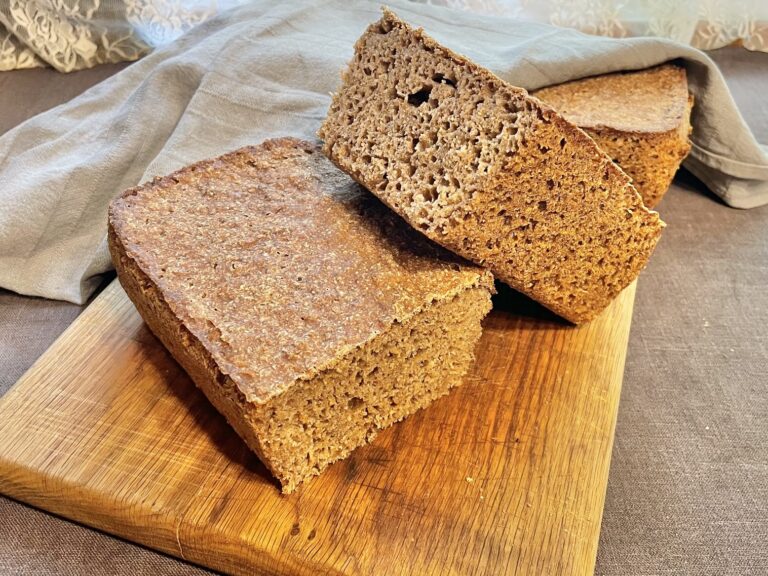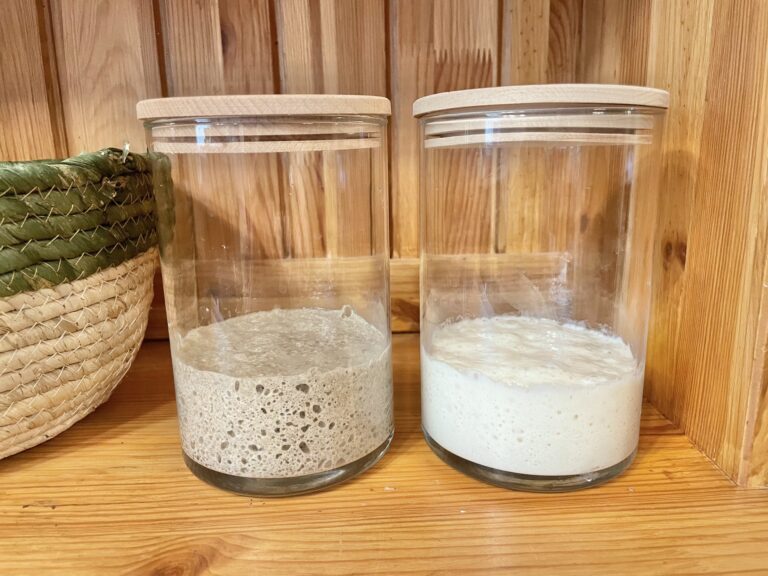This is a perfect recipe for family pizza night. With this recipe, you’ll have the best sourdough pizza rolls, and I honestly think it’s one of the best ways to use sourdough!

Before starting, come and follow me on Instagram, Facebook, and Pinterest!
Pizza rolls made with this sourdough recipe are delicious and soft. One of my favorite things is that with carefully selected ingredients, sourdough-raised pizza rolls are very healthy and don’t leave you feeling like you’ve done your body any harm after eating.
If you’re not yet familiar with sourdough or don’t have your own starter, here is a thorough guide to getting started. In my family, we use sourdough all the time. Everyone’s used to it, and it’s completely normal for us. Yeast is “off-limits” in our household, and we don’t use the word! 🙂
Sourdough baking often takes a lot of time and requires planning a day or two for successful results. I often feel the urge to bake something, but the idea that it will only be ready the next day can take away my enthusiasm. But pizza rolls can be ready to eat the same evening if you start in the morning. Isn’t that wonderful?
Pizza Rolls vs. Traditional Pizza
Pizza rolls taste very similar to traditional pizza, and you can use all the same toppings if you like. The difference is in the dough – for pizza rolls, the dough is soft and fluffy, not thin like typical pizza dough. When it comes to kids, I would always choose pizza rolls, as they are much easier for them to eat.
Storing Pizza Rolls
The best way to store pizza rolls is to freeze them before the second rise. This way, you can take the rolls out of the freezer, thaw, and bake them. They’ll be just like fresh.
If already baked rolls are left over and starting to dry out, you can freeze them even after baking.

Reviving Dried-Out Pizza Rolls
To save rock-hard pizza rolls from going to waste, soak the rolls in water briefly so they absorb as much water as possible, then bake them in the oven for a short time until the water has evaporated. When they come out of the oven, place them under a damp towel, and you’ll be amazed—they’re like new!
FAQ
Can people with gluten intolerance eat sourdough pizza rolls?
Yes and no. People with gluten intolerance should consult a doctor, but those who are gluten-sensitive can likely enjoy sourdough-fermented foods. The sourdough-fermented dough contains very little gluten as the fermentation process breaks down the gluten. Fermentation should last as long as possible, at least 8 hours.
If the dough hasn’t risen enough, can I still bake it?
Yes, you can! Pizza rolls don’t need to rise much, and even if the dough isn’t very strong or fully risen, the rolls will still turn out fine.
Do I need to knead the dough until it’s smooth and released from my hands?
That’s a tricky question. If you’re making rolls to impress, aim for an elastic dough with a strong gluten network. However, if I’m making rolls at home, I’ve seen many times that even with weak sourdough, under-risen, and imperfectly kneaded dough, you can still bake something close to perfect. If you’re trying it for the first time, I’d recommend following the instructions fully to avoid disappointment.
Is a second rise necessary?
I’ll answer similarly to the previous question: it’s not necessary, and sometimes I skip it, but the rolls won’t rise as nicely in the oven. But honestly, that’s more of a finishing touch.

Ingredients
Check the recipe card at the bottom of the post for ingredient quantities and nutritional information!
Dough
All-purpose flour
Egg
Milk
Butter
Salt
Brown sugar or honey
Active sourdough starter
Stuffing
Ketchup or tomato paste
Cheese
Additional pizza toppings of your choice
Basil
Oregano

Making the Pizza
- Take a large bowl and mix all dough ingredients (the texture doesn’t need to be perfectly smooth) and let it rest for 15-20 minutes. After resting, the dough is much easier to mix. If you’re using a stand mixer, you can skip the resting.
- Start kneading the dough, turning the bowl as you lift and lower the dough with your hand. The goal isn’t to slap the dough against the bowl but rather to stretch it without tearing. If using a stand mixer, knead on speed 1 or 2, and don’t forget to use the dough hook. Using higher speeds may overheat the motor. Properly kneaded dough should eventually release from your hands and the bowl and should be stretchy, elastic and pass the windowpane test. Hand-kneading may take about 15 minutes, but if it’s your first time, it may take longer.
- Let the dough rise under a damp tea towel or put the bowl of dough in a closed oven for about 6–12 hours. Rising time depends greatly on the room temperature—the cooler the room, the longer it will take. After rising, the dough should have doubled.
- Sprinkle flour onto your work surface and flour the dough ball as well. Roll out the dough, but not too thinly—about 3mm (0,1 in) thickness is perfect. Ensure the horizontal side is longer than the vertical side relative to yourself.
- Spread olive oil on the dough. If you prefer salty foods, you can sprinkle a bit of salt.
- Spread tomato paste on top, followed by other toppings and seasonings in your preferred order.
- Roll the dough from the long edge.
- Use a sharp knife to slice the pizza rolls into equal pieces, aiming for 12 rolls: cut the dough in half, then halve those pieces again, and finally cut each section into three equal parts. You can also make the rolls thinner and smaller, but they may turn out harder and denser.
- Generously grease a baking sheet e.g., with unrefined oil or butter (no need for parchment paper.
- Place the rolls on it with equal spacing. You can also use a cast iron skillet, a stainless-steel pan, or a glass baking dish.
- For perfect shaping, spread them outward from the center with your fingers as if trying to “open” the rolls
- Let the sourdough rolls rise in a warm spot for another couple of hours for maximum fluffiness. You can skip this step if you prefer.
- For a glossy finish, brush the rolls with a beaten egg.
- Bake the rolls on the middle rack at 200°C (390°F) for 15–20 minutes until golden brown on top. The preheated oven isn’t essential, putting the rolls into the cold oven is perfectly fine.
- After baking, immediately place the rolls in a bowl and cover with a damp towel. Leaving the rolls to cool on a hot pan can make them hard and dry.
- Serve with dipping sauce.

Baking Schedule
Starting in the Morning
10:00 pm (the night before) – Feed sourdough starter
8:00 am – Next morning mix all ingredients and let rest for 20 minutes
8:20 am – Knead dough and leave to rise in a bowl for 6–12 hours
6:00 pm – Assemble pizza rolls, place on a baking sheet, and let rise for 2-4 hours
8:00 pm – Bake pizza rolls for 15–20 minutes
Starting in the Early Evening
5:00 pm – Feed sourdough starter
9:00 pm – Mix all ingredients and let rest for 20 minutes
9:20 pm – Knead dough and leave to rise overnight
8:00 am – Next morning make pizza rolls, place on a baking sheet, and let rise for 2-4 hours
10:00 am – Bake pizza rolls for 15–20 minutes
Tips and Ideas
- If you have a stand mixer, use it for larger batches. While it may not save much time, it saves energy. But if you want a workout, go ahead and knead by hand!
- Use flour with at least 12% protein for the best rise. Avoid overly refined flour.
- Don’t roll the dough too thin or narrow. Let the dough remain somewhat thick, or the rolls may turn out hard and more like cookies.
- Use your favorite pizza toppings, for example, olives or mozzarella cheese. Make your favorite pizza topping combination!
- If you knead the dough by hand, use a heavy ceramic bowl to keep it stable.
- For slicing, you can use unflavored, fluoride-free dental floss.
- Try making cinnamon rolls with sourdough as well.
- I prefer grated cheese, but sliced cheese works too.


How to Make Homemade Stuffed Sourdough Pizza Rolls
With this recipe, you'll have the best sourdough pizza rolls, and I honestly think it's one of the best ways to use sourdough!
Ingredients
Dough
- 250g of all-purpose flour
- One egg
- 100g of milk
- 50g of butter
- 5g of salt
- 50g of brown sugar or honey
- 75g of active sourdough starter
Stuffing
- 4-5 tbsp ketchup or tomato paste
- 300g of cheese
- 300g additional pizza toppings of your choice
- Basil
- Oregano
Instructions
- Take a large bowl and mix all dough ingredients (the texture doesn’t need to be perfectly smooth) and let it rest for 15-20 minutes. After resting, the dough is much easier to mix. If you’re using a stand mixer, you can skip the resting.
- Start kneading the dough, turning the bowl as you lift and lower the dough with your hand. The goal isn’t to slap the dough against the bowl but rather to stretch it without tearing. If using a stand mixer, knead on speed 1 or 2, and don't forget to use the dough hook. Using higher speeds may overheat the motor. Properly kneaded dough should eventually release from your hands and the bowl and should be stretchy, elastic and pass the windowpane test. Hand-kneading may take about 15 minutes, but if it’s your first time, it may take longer.
- Let the dough rise under a damp tea towel or put the bowl of dough in a closed oven for about 6–12 hours. Rising time depends greatly on the room temperature—the cooler the room, the longer it will take. After rising, the dough should have doubled.
- Sprinkle flour onto your work surface and flour the dough ball as well. Roll out the dough, but not too thinly—about 3mm (0,1 in) thickness is perfect. Ensure the horizontal side is longer than the vertical side relative to yourself.
- Spread olive oil on the dough. If you prefer salty foods, you can sprinkle a bit of salt.
- Spread tomato paste on top, followed by other toppings and seasonings in your preferred order.
- Roll the dough from the long edge.
- Use a sharp knife to slice the pizza rolls into equal pieces, aiming for 12 rolls: cut the dough in half, then halve those pieces again, and finally cut each section into three equal parts. You can also make the rolls thinner and smaller, but they may turn out harder and denser.
- Generously grease a baking sheet e.g., with unrefined oil or butter (no need for parchment paper.
- Place the rolls on it with equal spacing. You can also use a cast iron skillet, a stainless-steel pan, or a glass baking dish.
- For perfect shaping, spread them outward from the center with your fingers as if trying to "open" the rolls
- Let the sourdough rolls rise in a warm spot for another couple of hours for maximum fluffiness. You can skip this step if you prefer.
- For a glossy finish, brush the rolls with a beaten egg.
- Bake the rolls on the middle rack at 200°C (390°F) for 15–20 minutes until golden brown on top. The preheated oven isn't essential, putting the rolls into the cold oven is perfectly fine.
- After baking, immediately place the rolls in a bowl and cover with a damp towel. Leaving the rolls to cool on a hot pan can make them hard and dry.
- Serve with dipping sauce.
Nutrition Information:
Yield: 12 Serving Size: 1Amount Per Serving: Calories: 346Total Fat: 15gSaturated Fat: 8gTrans Fat: 0gUnsaturated Fat: 5gCholesterol: 54mgSodium: 771mgCarbohydrates: 41gFiber: 2gSugar: 13gProtein: 12g





Wonderful recipe! I love finding people all over the world and learning their recipes.